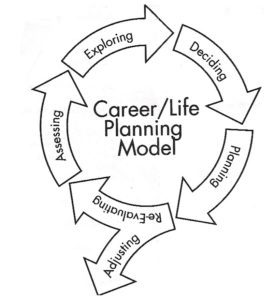CAREER DESIGNING: DECIDE PLAN
Last time, we discuss Assess and Explore; now, we will focus on Decide and Plan as you navigate Career Designing.
Career Designing: Assess Explore
As stated previously, regardless of where you are along the path to becoming an architect—starting or completing your architectural education, gaining experience in an architecture firm or in the process of taking the Architect Registration Exam (ARE), you should pursue deliberate career designing to maximize career success.
Career Designing helps you determine your skills and interests, what career best suits your talents, and what skills and training you need for your chosen career. By career designing, you can focus on what you want to do and how to get there.
But most importantly, how do you do career designing? From our perspective, there are four basic steps, the last two of which we will discuss in this essay.
- Assessing
- Exploring
- Deciding
- Planning
What most people want out of life, more than anything else, is the opportunity to make choices. – David P. Campbell
DECIDE: Decision-making is the heart of the career designing process. Design development describes the specific character and intent of the entire project; it further refines the schematic design and defines the alternatives. Decision-making means selecting alternatives and evaluating them against a predetermined set of criteria.
How do you make decisions? Do you let others decide for you? Do you rely on gut-level reactions? Or do you follow a planned strategy of weighing alternatives? Whatever your method of deciding, you should be aware of it. While some decisions can be made at the drop of a hat, others, including career designing, require more thought.
Decision-making can be difficult and time-consuming but knowing that the quality of decisions is affected by the information used to make them, you will quickly realize that making informed decisions is an important skill to learn.
Both exploring and decision-making are critical steps in successful career designing. Do not wait to begin this important process; instead, take this information and build your future with career designing.

Planning is bring the future into the present so that we can do something about it now. – Alan Lakein
PLAN: Half of reaching your destination is to know the direction in which you wish to head. Planning is key to fulfilling your career goals.
After the owner/client and architect decide upon a design for a potential building, the next step is the development of plans. These plans—construction documents, specifications, and schedules—all play an important role in realizing the design. In a similar way, planning, as part of the career development process, ensures that a successful career will be realized.
In its simplest form, planning is the bridge from dreams to action; it is merely an intention to take an action by a certain time. At its fullest, planning is creating a mission statement, developing career goals, and preparing action plans.
You will want to develop goals that will lead to the fulfillment of your mission statement. Goals are future-oriented statements of purpose and direction to be accomplished within a specified time frame. They are steppingstones in achieving long-range aims and should be specific and measurable. Write down your goals. It has been said that the difference between a wish and a goal is that a goal is written down.
Once you establish your goals, you are ready to develop the action plan that will help you accomplish them. Action plans are steps on the path toward your goals; they are steppingstones in achieving related short-range intentions. Look at your accomplished goals. What steps must you take to accomplish them? As with career goals, write down your action plan, including specific completion dates.
The final step in planning is to review your action plans and goals regularly. Cross out the goals you have accomplished and revise, add to, or delete others. Be honest with yourself. Are you still committed to achieving your goals? You can change them but remember that the magic road to achievement is persistence. Abandon goals only if they have lost meaning for you—not because they are tough, or you have suffered a setback.
Now, you understand the career/designing process: assessing, exploring, decision-making, and planning, you can implement it. As you progress through your professional career, you will realize that this process is never-ending and cyclical. As soon as you have secured an ideal position in a firm, you will wish to assess your new life situation and adjust your career design accordingly. As well, consider the following:
You know the story of the three brick masons. When the first man was asked what he was building, he answered gruffly, without even raising his eyes from his work, “I am laying bricks.” The second man replied, “I am building a wall.” But the third man said enthusiastically and with obvious pride, “I am building a cathedral.” — Margaret Stevens
In your future career, will you lay bricks, build a wall, or build a cathedral? Regardless of your answer, designing your career is one of the most important tasks during your lifetime. Yet if career designing is so important, why do most people spend such little time on it? Think about it!
